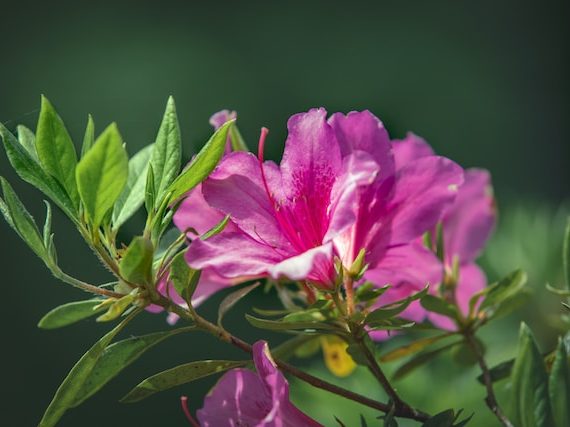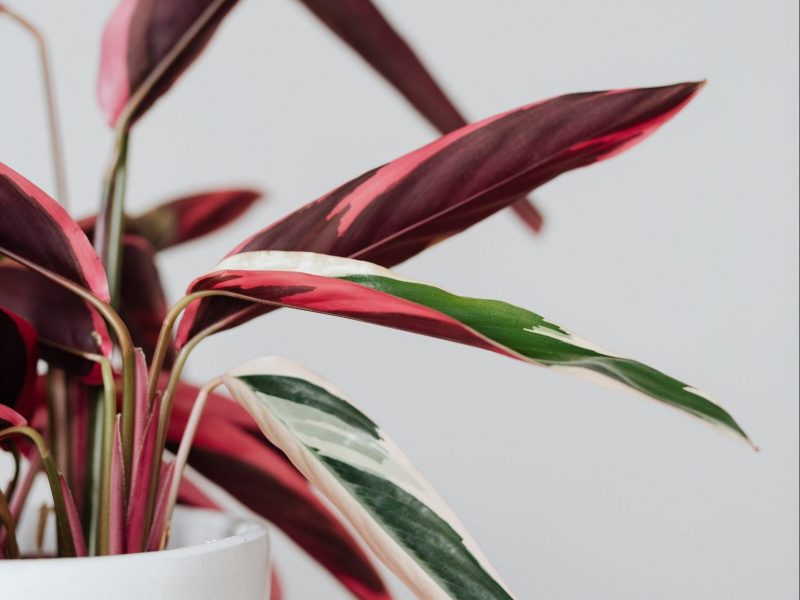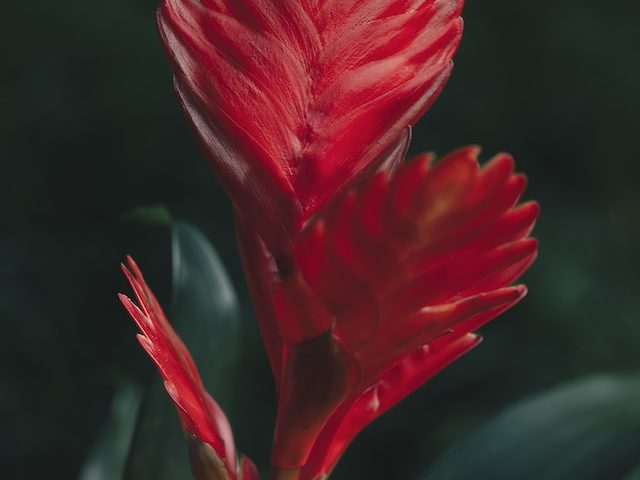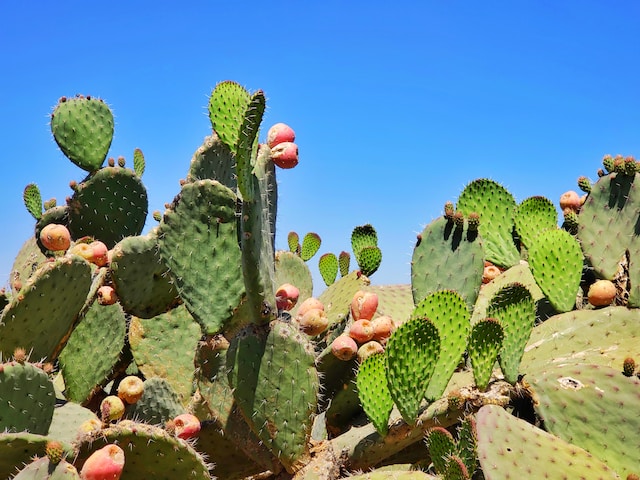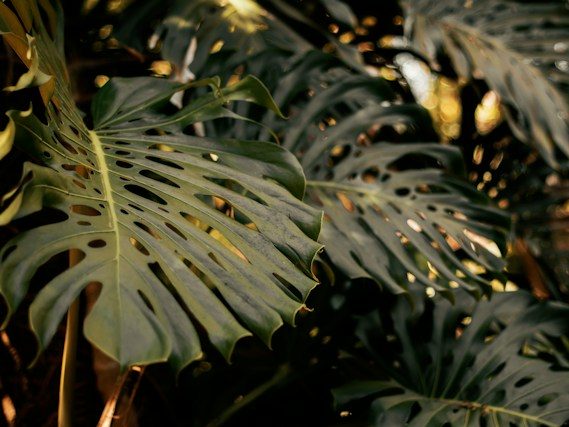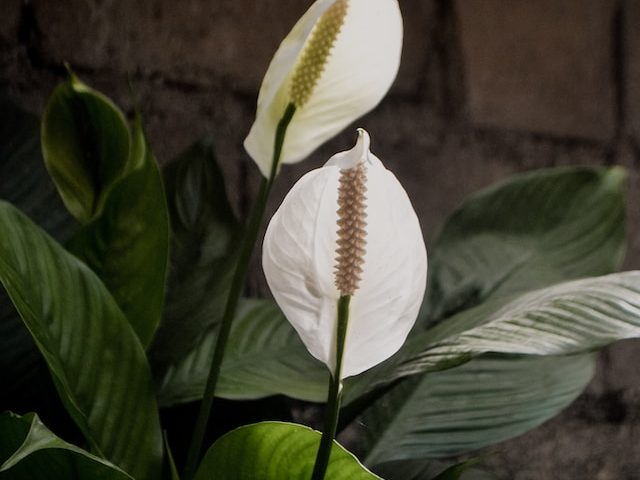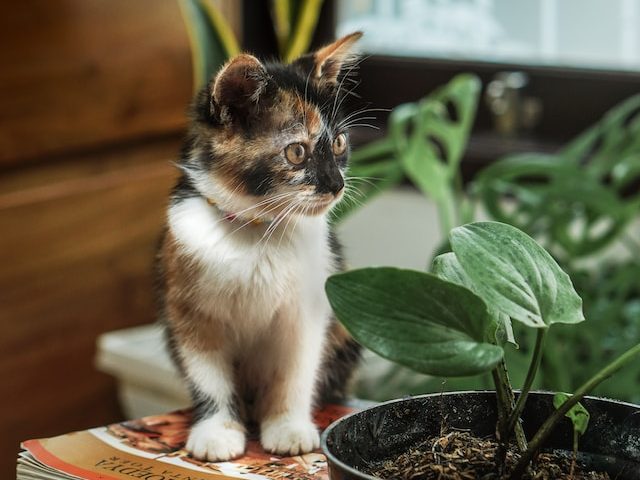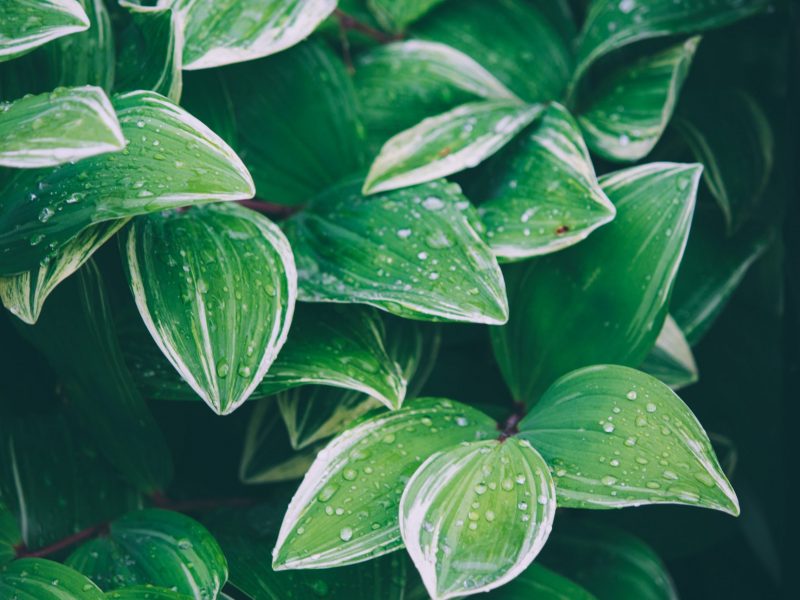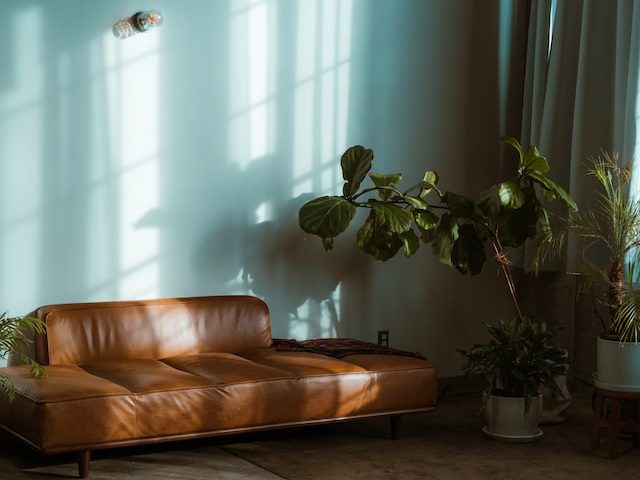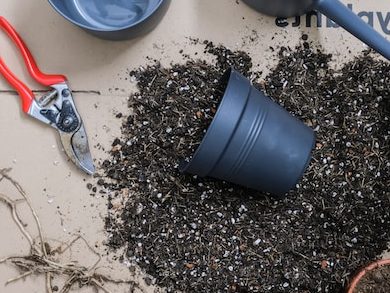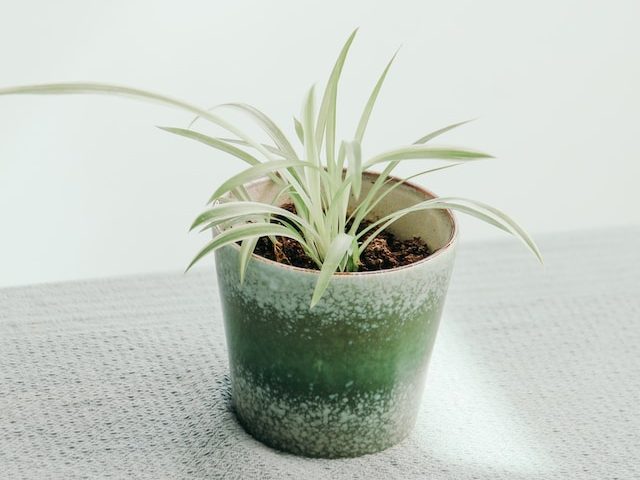Calathea Triostar
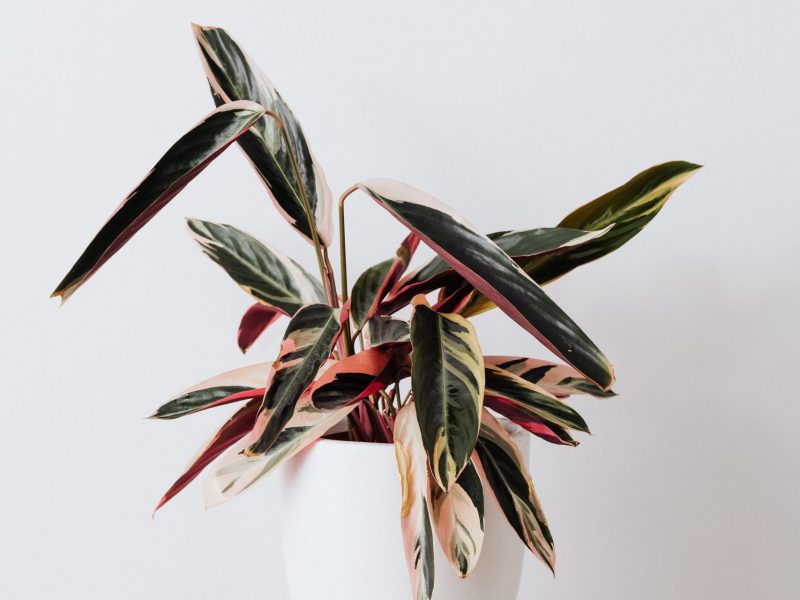
Introduction to Calathea Triostar
If you’re looking for a houseplant with striking colors, Calathea Triostar is one of our favourite options. This vibrant plant is known for its dazzling variegated leaves that feature shades of green, white, pink, and even burgundy on the undersides.
Native to the Brazilian rainforest, Calathea Triostar has made its way into many homes and hearts worldwide, thanks to its unique aesthetic appeal and fairly easy care routine.
Appearance of the Calathea Triostar
What makes the Calathea Triostar a standout is its spectacular foliage. The leaves are long and lance-shaped and the top is covered in a cream, green, and pink pattern, while the undersides reveal a rich burgundy hue.
Size and Growth Rate
Calathea Triostars are medium-sized houseplants. When given the right care and conditions, it can reach up to 2-3 feet in height. The plant’s growth is relatively slow, and it takes a few years to reach its full size but it’s definitely worth the wait!
Natural Habitat
Understanding a plant’s natural habitat can provide insights into its care needs. In its native environment, Calathea Triostar plants grow under the canopy of the Brazilian rainforest, where it receives filtered light, high humidity, and a stable temperature. These are the conditions we aim to replicate when caring for this plant indoors..
Growth Habit
The Calathea Triostar has a compact growth habit. It grows upright to a moderate height, making it an ideal choice for small spaces. You’ll notice that the plant occasionally sends out new shoots directly from the soil, contributing to a bushier appearance.
Light Requirements for Calathea Triostar
Calathea Triostar plants thrive in medium sunlight and don’t do well with harsh intense light as it can quickly burn and dry out the leaves. On the other hand, low light levels can cause smaller and less variegated leaves, although your plant often will be able to adapt to some extent.
Indoor settings can be tricky when trying to provide the right light conditions for your Triostar. Here are a few tips:
- Place the plant near a north or east-facing window, where it can receive gentle morning sunlight and avoid harsh afternoon rays.
- Ensure the plant isn’t placed directly next to the window as cold drafts or heat from the glass can damage the leaves.
- Use sheer curtains or blinds as a buffer to diffuse sunlight, preventing direct rays from hitting the plant.
Artificial Lighting for Your Calathea Triostar
If your home doesn’t have enough natural sunlight for your Calathea, artificial light can also work. Here’s are a few tips:
- Use fluorescent lights or specialized grow lights to supplement natural light.
- Position the plant about 2 feet away from the light source to avoid overheating and leaf burn.
- Keep the lights on for approximately 12 hours a day to mimic a natural day-night cycle.
Watering Calathea Triostar: How Much and How Often?
How Much:
The amount of water your Calathea Triostar requires can vary depending on several factors. These include the size of your plant, the size of its pot, the type of soil you’ve used, and the current season or climate. As a general rule, try to keep the top inch of your plant’s soil moist, but not waterlogged.
Water enough so that some water flows out from the drainage holes at the bottom. This ensures a nice even moisture throughout the pot. But do remember to remove any excess water about 20 minutes after watering to minimize the potential of overwatering.
How Often:
In general, watering your Calathea Triostar once a week should suffice. However, this can vary depending on the conditions in your home. In warm, dry conditions, you might need to water your plant more frequently. In cooler, more humid conditions, your plant may require less frequent watering.
Here are a few tips to help you water your Calathea Triostar effectively:
- Check the soil: Before watering, always check the top inch of soil. If it feels dry, it’s time to water your plant. If it’s still moist, hold off on watering for a few more days.
- Use lukewarm water: Tropical plants like the Calathea Triostar aren’t fans of cold water and it can cause your plant to become shocked. Use lukewarm water to avoid damaging your plant’s roots.
- Don’t overwater: Overwatering can lead to root rot, a serious condition that can kill your plant. Avoid the temptation to water your Triostar too frequently.
Temperature and Humidity Needs of Calathea Triostar
When it comes to the well-being of your Calathea Triostar, temperature and humidity play pivotal roles but are very often forgotten as the emphasis is only placed on sunlight and watering habits.
The Calathea Triostar is accustomed to warm and humid environments, so it’s important to mimic these conditions as closely as possible in your home.
Temperature:
The ideal temperature for a Calathea Triostar ranges between 60°F and 85°F. They do not tolerate cold drafts or low temperatures well, so you must ensure your plant is situated in a room that consistently maintains the correct temperature range.
Note: Avoid placing your Calathea Triostar near air conditioning vents, open windows during cold weather, or other drafty spots.
You also need to watch out for high temperatures as this can dry out your plant quickly and cause brown leaves. Avoid placing your plant too close to windows where hotspots can occur and be wary of the placement near radiators, cookers and heating vents.
Humidity:
Calathea Triostar loves high humidity and this is a really important element in getting the care just right. Aim to keep the humidity level above 50% for these plants to truly thrive and it will really help to avoid brown tips and leaf edges which can be common in plants with lance-shaped leaves. In drier environments, you might need to take some extra steps to increase the humidity around your plant for example:
- Misting: This is by far one of the easiest ways to boost humidity.
- Humidifier: If your home’s air is particularly dry, consider investing in a humidifier as a nice easy way to get the job done without you really having to do anything.
- Pebble tray: Place your plant pot on a tray filled with pebbles and water. As the water evaporates, it will increase the humidity around the plant.
Calathea Triostar Leaves
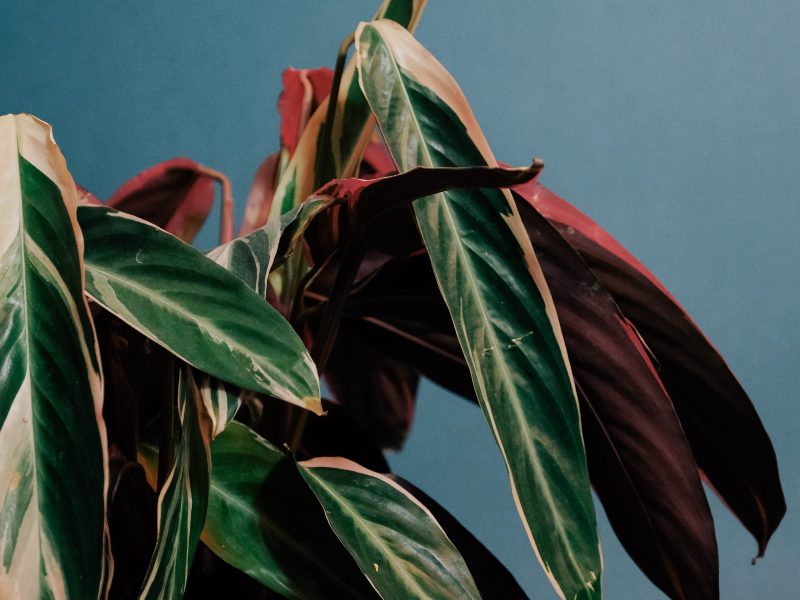
Fertilizing a Calathea Triostar: Tips and Recommendations
Just like most other houseplants, the Calathea Triostar needs a nutrient boost from time to time and fertilizing is the best way to do this. It’s not a complicated process, but it does require some knowledge and care to get it right.
When to Fertilize
Generally, the Calathea Triostar benefits from being fertilized only during its active growing season. This typically falls between spring and summer. During these months, consider fertilizing your plant every four weeks. In fall and winter, it’s best to stop fertilizing altogether as your plant will enter a dormant period.
Choosing the Right Fertilizer
When deciding on a fertilizer, opt for a balanced, water-soluble houseplant fertilizer. A balanced fertilizer means it has equal parts Nitrogen (N), Phosphorous (P) and Potassium (K). These three elements are essential to plant health and are often represented as a ratio on the fertilizer packaging, such as 10-10-10.
How to Fertilize
Fertilizing your Calathea Triostar is a simple process. Here are some steps to guide you:
- Prepare the fertilizer by diluting it in water according to the package instructions (often we dilute even further than suggested to avoid any overfertilization).
- Before applying the fertilizer, ensure your plant’s soil is damp. This can be achieved by watering your plant a day before fertilizing as this helps to avoid fertilizer burning the roots.
- Apply the diluted fertilizer to the soil. Be careful not to splash any on the plant’s leaves as this could cause leaf burn.
- After fertilizing, wait at least a month before repeating the process.
Choosing the right pot and soil for your plant
Selecting the right pot
Make sure to select a pot that has good drainage as the Calathea Triostar dislikes waterlogged conditions. A pot with holes at the bottom is ideal to prevent water from sitting at the base of the pot, which could lead to root rot.
As for size, choose a pot that is slightly larger than the root ball of your plant. This gives it space to grow without becoming root-bound too soon. On the other hand, a pot that’s too large can retain excessive moisture and may potentially cause some instability.
Soil Selection
When it comes to soil, the Calathea Triostar prefers a well-draining mix. A combination of peat and perlite is often recommended. This mix retains enough moisture for the plant’s roots, but drains excess water quickly to prevent waterlogging.
Here’s a simple recipe you can try:
- Two parts peat moss: This component helps to retain moisture and provides organic material for your plant.
- One part perlite: This light, volcanic rock helps to improve drainage and aeration in the soil.
Pruning a Calathea Triostar
Pruning a Calathea Triostar is an essential part of the plant’s care routine but so many plant parents either forget about it or are too scared to do it. Pruning not only keeps your plant looking tidy and attractive but also promotes healthier growth by removing old, damaged, or diseased leaves.
When to Prune
The best time to prune your Calathea Triostar is during its active growth period, typically in the spring or summer. This is because the warm sunny weather will help your plant recover from the shock of pruning. However, you can remove dead or yellowing leaves at any time of the year.
Tools Needed
- Pruning shears: Choose a pair with sharp, clean blades to avoid causing damage to the leaves.
- Gloves: These will protect your hands during the pruning process.
Pruning Procedure
- Identify the leaves to be pruned: Look for leaves that are yellowing, browning, or withering. These leaves are usually older and can be removed. If the rate of discolouration of the leaves is faster than the rate of your plant growing new ones, then this isn’t usually natural ageing so it’s important to diagnose the issue quickly.
- Make the cut: Using your pruning shears, cut the leaf at the base, close to the soil. Ensure the cut is clean and straight to prevent damage to the remaining part of the plant.
- Discard the cut leaves: Don’t leave the pruned leaves lying around as they can attract pests or diseases.
Post-Pruning Care
Once you’ve pruned your Calathea Triostar, it’s important to continue caring for it properly and ensuring it has the right environment to grow new leaves. This includes maintaining the right temperature, humidity, and watering routine. Your plant will reward you with vibrant, healthy growth.
Calathea Triostar Red Leaves
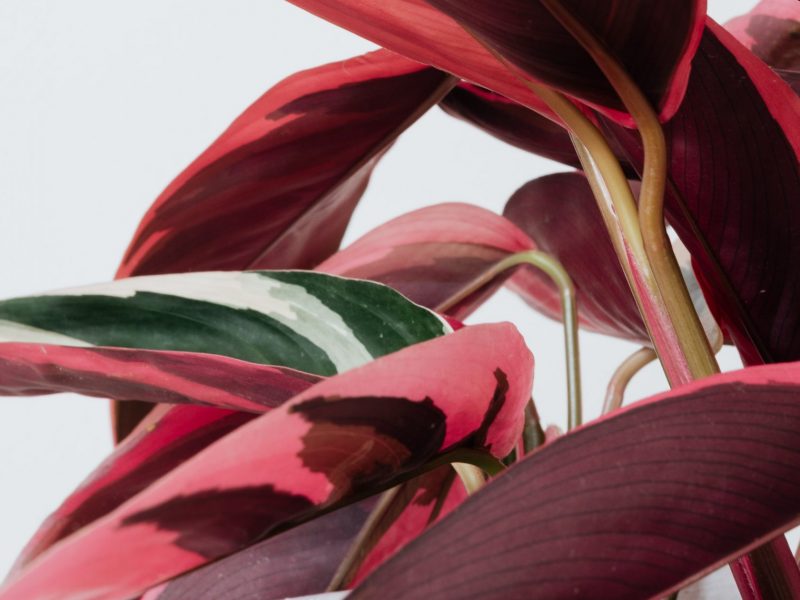
Toxicity of the Calathea Triostar
The Calathea Triostar is non-toxic, making it a perfect addition to homes with pets or children. It’s rated as safe for both cats and dogs by the American Society for the Prevention of Cruelty to Animals (ASPCA). The plant also doesn’t pose any risk to human health, making it an ideal choice for households with curious toddlers or infants.
Safe Interaction with the Plant
While the Calathea Triostar is non-toxic, it’s still recommended to prevent pets from chewing on the leaves. Although it won’t result in poisoning, dogs and cats might experience minor discomfort or gastrointestinal upset if they ingest large amounts of any plant material.
Necessary Precautions
Even though the Calathea Triostar is safe, there are some precautionary measures that should be taken into account. Owners should avoid using chemical fertilizers or pesticides that may be harmful if ingested. Opt for organic plant care products wherever possible, particularly if you have children or pets.
Flowers on a Calathea Triostar
Although the Calathea Triostar is known for its multicolored foliage rather than its flowers, under optimal conditions, it may surprise you with small white or pink blooms.
Understanding Calathea Triostar Flowering
Flowering is not a common occurrence in Calathea Triostar, especially when grown indoors. The plant channels most of its energy into producing its spectacular variegated leaves. But with the right care, you might be lucky enough to see it bloom.
The flowers are usually small and tucked among the leaves and their color can vary from white to a light shade of pink. The flowering usually occurs during the warmer months of the year and when your plant is receiving the right care.
What to Do After Flowering
Once your Calathea Triostar has flowered, it’s important to remove spent blooms. This process, known as deadheading, helps the plant conserve energy for leaf production and potential future flowering. Simply snip off the faded flowers at their base using clean, sharp scissors.
Common Pests and Diseases
Common Pests
The most common pests that attack Calathea Triostar are spider mites, mealybugs, and scale insects.
- Spider mites: They are tiny, spider-like creatures that can be identified by the fine, silky webbing they leave on the foliage. They suck the sap from the plant, causing the leaves to become yellow and dry. Regularly misting your plant and wiping the leaves can help deter these pests.
- Mealybugs: These are small, cotton-like pests that are often found in warm, moist environments. If left untreated, they can cause the leaves to yellow and drop. To eliminate them, you can use a cotton swab dipped in alcohol to wipe the plant.
- Scale insects: These are brown or grey, shield-like bugs that stick to the plant and suck out its nutrients. Scraping them off gently or using an insecticidal soap can help in their removal.
Common Diseases
- Leaf Spot: This condition is recognized by yellow or brown spots on the leaves. It’s usually a result of overwatering or poor drainage. Cut off the affected leaves and ensure your plant is watered properly, giving it time to dry out between watering.
- Root Rot: This is often caused by overwatering where the roots become soggy and start to decay. If you notice a stale smell or see black, mushy roots, it’s likely your plant is suffering from root rot. Repot the plant in fresh soil and maintain a proper watering schedule to combat this issue.
In general, remember that maintaining a clean environment and proper watering schedule are the best ways to keep your Calathea Triostar healthy and free from pests and diseases.
Common Problems with your Calathea Triostar
Here are some common issues that you might run into. It’s important to diagnose any issues early to give your plant the best chance of bouncing back.
Why does my Calathea Triostar have yellow leaves?
If you notice that your Calathea Triostar is starting to develop yellow leaves, it is usually caused by overwatering. Check the moisture in the soil and replace if necessary. In future, we recommend using a moisture meter to ensure you only water your Calathea when needed. You can also use terracotta pots rather than plastic ones which allow some of the water to escape out of the sides.
Why has my Calathea Triostar developed pale leaves?
Pale leaves on a Calathea Triostar are a sign that there is too much moisture in the soil. Adjust your watering schedule and make sure there are drainage holes in the pot (and that they are not blocked by anything).
Why are there brown edges on my Calathea Triostar's leaves?
Dry, cirpsy brown edges on the leaves of your Calathea Triostar is a signal that either it needs to be watered more often, or that the humidity levels are too low. The easiest way to increase the humidity level is by using a humidifier. You can find out more about how to increase the humidity for your houseplants in our guide.
Why is my Calathea Triostar wrinkly and looking withered?
Wrinkly, withered leaves on a Calathea Triostar are a sign that the air in the room is too dry. Try to mist your plant regularly using a spray bottle or move it to the kitchen or bathroom where humidity levels are naturally higher. We also recommend every plant parent use a humidifier to keep a nice constant humidity level in your home.



